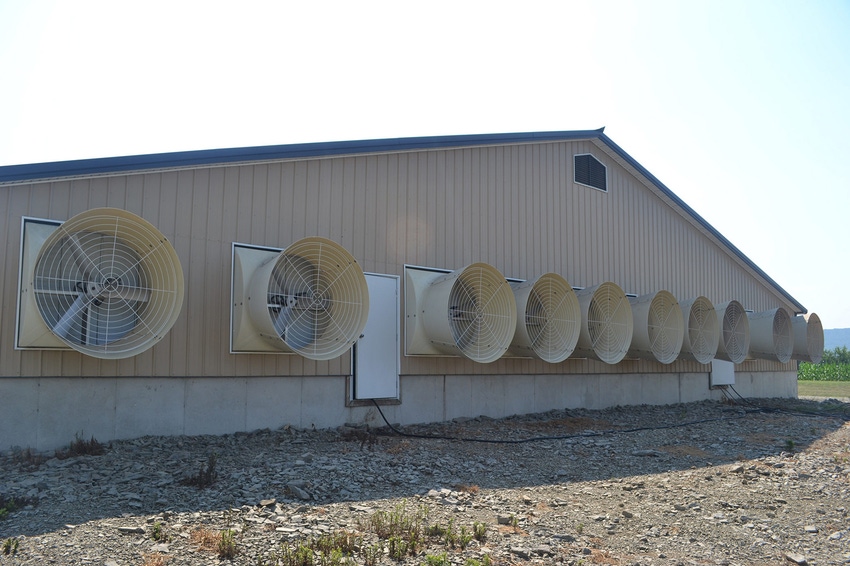All too often, the difference between how Minimum Ventilation systems are designed and how they are operated is commonly confused or unknown.
January 24, 2017

By Brett C. Ramirez, Iowa State University Department of Agricultural and Biosystems Engineering Graduate Research Assistant
As we enter the middle of winter, it is essential we revisit the importance and role of Minimum Ventilation. It is understood that poor ventilation during the winter months can lead to moisture problems, hazardous gas build-up, and in general, a poor environment for both the pigs and workers. However, on many occasions, the difference between how we design for MV and how we operate the MV stage is commonly confused or unknown. This column aims to clarify this difference and provide readers with some suggestions to help improve MV in their barns.
Let us first start by separating the objective of MV during the design phase, which is primarily for fan sizing, in contrast with when the ventilation system is operational, which is to maintain an acceptable environment inside the room for the occupants ─ then we will go through each in more detail. During the design phase, engineers determine the fresh air ventilation rate that is needed to remove either generated hazardous gases, moisture or heat from the room based on the number of pigs, design climatic conditions and other guidelines. Typically, the MV rate selected is to maintain moisture in the air at an acceptable level (e.g., a target relative humidity of 60%), with the idea in mind that, for example, ammonia, can be maintained at an acceptable level, without suffering high propane consumption. This ventilation rate is known as the MV rate and is then used to determine the size and number of fan(s) that will provide this rate. Often times, most people know and use the 2 cubic feet per minute per head for wean-finish pigs from Midwest Plan Service, instead of going through the fundamental calculations.
These two approaches basically describe the same concept, that is, how much fresh air is required to remove the moisture produced inside the room. While data and years of experience are built into the MWPS values, the specific barn style, barn construction, manure system, pigs, etc., can substantially impact what ventilation rate is actually needed. The MV rate determined during the design phase is only to make sure the ventilation system has the capacity to remove generated moisture, gases, heat, etc., in order to maintain acceptable levels inside the barn. Whether or not the ventilation system truly achieves this rate or even needs to when operating, is a completely different story.
Now let us shift to when the barn is occupied with pigs and the MV stage (with the number and size of fans from the design phase) is operating. Precisely knowing if the MV stage is providing the 2 cubic feet per minute per head is not essential. It is more critical to make sure that when the MV stage is operating, the environment inside the barn is acceptable for both pigs and workers. This is where the difference between design and operation of MV exists. Many factors affect the ventilation rate that are not accounted for or that may have changed from the design phase, and are only available during operation. Factors such as operating static pressure, inlet position, tightness of the construction, soffit/ridge open areas, fan wear and maintenance, etc., all effect ventilation rate.
Thus, the only way to know if you are correctly ventilating at the MV stage is through measurements or observations of the conditions actually resulting from operation. Rather than attempting to measure the ventilation rate, which can be quite expensive, monitoring moisture or gas concentrations inside the barn and checking if the pigs look comfortable, may be a better alternative. If a higher ventilation rate appears to be needed, things to inspect include, static pressure across the building envelop, excessive leakage, cleanliness of shutters, correct soffit/ridge openings, inlet staging, etc. For example, oversized variable speed fans used for the MV stage, require, in many cases an operating percentage so low that wind effects can reduce the required MV air. Further, the use of a single speed fan for the MV stage can help reduce problems associated with throttled back variable speed fans. Alternatively, if less fresh air is needed, fan and inlet adjustments can be made accordingly. Use the environment inside the barn as feedback, not the ventilation rate.
The MV rate plays a major role in providing an environment that is acceptable for both pigs and workers. It is equally important to understand the difference between using the MV rate for design and determining if the MV rate is maintaining the quality of the environment inside the barn that is desired. The MV rate stated in MWPS (2 cubic feet per minute per head) is for design, that is, the ventilation rate needed to select the appropriate fans to remove generated moisture. During operation, it may take more ventilation or less, depending on many conditions and influences within the barn. In a perfect world, the estimated design relative humidity inside the barn matches the actual; however, many factors come into play between design and operation phases that all combine to affect what the actual MV rate needs to be.
Therefore, it is imperative to determine if the pigs need more or a less ventilation, not if the fan(s) are achieving the design value.
The next column will go into more detail on the impact of construction integrity on air distribution during MV.
You May Also Like



